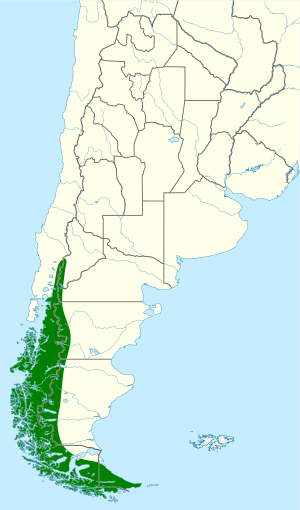White-throated caracara facts for kids
Quick facts for kids White-throated caracara |
|
|---|---|
 |
|
| Conservation status | |
| Scientific classification | |
| Genus: |
Phalcoboenus
|
| Species: |
albogularis
|
 |
|
| Synonyms | |
|
Daptrius albogularis |
|
The white-throated caracara (Phalcoboenus albogularis), also known as Darwin's caracara, is a fascinating bird of prey. It belongs to the Falconidae family, which includes falcons and other caracaras. You can find this bird living in parts of Argentina and Chile in South America.
Contents
About the White-Throated Caracara
What Kind of Bird Is It?
The white-throated caracara is part of a group of birds called Falconiformes. This group includes many different species of birds of prey. Scientists often group animals into categories to understand them better. The white-throated caracara is closely related to the carunculated caracara and the mountain caracara. These three birds are so similar that scientists call them a "superspecies." This means they are very close relatives.
What Does It Look Like?
This caracara is about 49 to 55 centimeters (19 to 22 inches) long. Its wings can spread out wide, from 110 to 124 centimeters (43 to 49 inches). It has a small crest on its head and long wings. The tips of its wings look like "fingers" when it flies. Its tail is long and rounded.
Adult white-throated caracaras have brownish-black or black feathers on their upper body. Their lower body and the tips of their tail feathers are pure white. The skin on their face is yellow-orange. Their eyes are hazel or brown, and their legs and feet are yellow. Young caracaras look a bit different. They have dark brown upper parts and bluish-white skin on their face, legs, and feet.
Where Does It Live?
Habitat and Location
The white-throated caracara lives in the southernmost parts of South America. You can find it in south-central Chile and western Argentina. Its home stretches all the way down to Tierra del Fuego and Cape Horn.
These birds like to live in open mountain areas. They also live in forests with southern beech trees, which are called Nothofagus forests. You might also see them in open woodlands and thick scrublands. In Chile, they live at heights from about 500 to 2,500 meters (1,600 to 8,200 feet) above sea level. In Argentina, they can be found from sea level up to 3,000 meters (9,800 feet) high.
How Does It Live?
Movement and Travel
Scientists are still learning about how the white-throated caracara moves around. They think these birds might be a bit nomadic. This means they travel from place to place rather than staying in one spot all the time.
What Does It Eat?
We don't know a lot about what the white-throated caracara eats or how it finds food. However, we do know it eats carrion, which is the meat of dead animals. For example, it might eat dead guanacos or cattle. It has also been seen hunting and eating small rodents.
Sometimes, small groups of these caracaras will gather with vultures to eat from large dead animals. They also join other caracara species where sheep are slaughtered. They will even try to scare away other birds to get more food for themselves! It's thought that they look for food while flying, unlike some other caracaras that walk on the ground.
Reproduction and Life Cycle
Not much is known about how the white-throated caracara raises its young. They build their nests out of sticks on rocky ledges. A female caracara usually lays two or three eggs. This probably happens in October or November. We don't know how long the eggs take to hatch or when the young birds are ready to fly. We also don't know many details about how the parents care for their chicks.
Vocalization and Sounds
There are not many recordings of the white-throated caracara's calls. People say its call sounds like a deeper version of the Chimango caracara's call. The Chimango caracara is known for its "peevish whinings."
Status and Protection
The IUCN (International Union for Conservation of Nature) has listed the white-throated caracara as a species of "Least Concern." This means they are not currently worried about it becoming endangered. Even though it lives in a specific area and has fewer than 6,700 adult birds, its population seems to be stable.
There are no immediate threats to this bird. It is quite common in Nothofagus forests and lives in at least three national parks. Its home is not often disturbed by people, and there are no reports of people harming these birds. So, for now, it is not a species that needs urgent protection.
Images for kids
See also
 In Spanish: Caracara araucano para niños
In Spanish: Caracara araucano para niños




